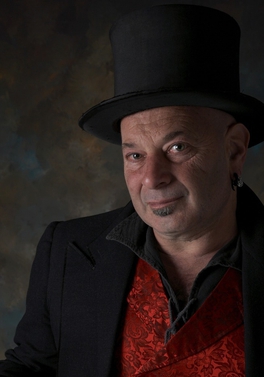
Gardnerian Wicca, or Gardnerian witchcraft, is a tradition in the neopagan religion of Wicca, whose members can trace initiatory descent from Gerald Gardner. The tradition is itself named after Gardner (1884–1964), a British civil servant and amateur scholar of magic. The term "Gardnerian" was probably coined by the founder of Cochranian Witchcraft, Robert Cochrane in the 1950s or 60s, who himself left that tradition to found his own.

Skyclad refers to ritual nudity in Wicca and Modern Paganism. Some groups, or Traditions, perform most or all of their rituals skyclad. Whilst nudity and the practice of witchcraft have long been associated in the visual arts, this contemporary ritual nudity is typically attributed to either the influence of Gerald Gardner or to a passage from Charles Godfrey Leland's 1899 book Aradia, or the Gospel of the Witches, and as such is mainly attributed to the Gardnerian and Aradian covens.

Wicca is a modern neo-pagan syncretic religion. Scholars of religion categorize it as both a new religious movement and as part of the occultist stream of Western esotericism. It was developed in England during the first half of the 20th century and was introduced to the public in 1954 by Gerald Gardner, a retired British civil servant. Wicca draws upon a diverse set of ancient pagan and 20th-century hermetic motifs for its theological structure and ritual practices.

A Book of Shadows is a book containing religious text and instructions for magical rituals found within the Neopagan religion of Wicca. Since its conception in the 1970s, it has made its way into many pagan practices and paths. The most famous Book of Shadows was created by the pioneering Wiccan Gerald Gardner sometime in the late 1940s or early 1950s, and which he utilised first in his Bricket Wood coven and then in other covens which he founded in following decades. The Book of Shadows is also used by other Wiccan traditions, such as Alexandrian Wicca and Mohsianism, and with the rise of books teaching people how to begin following non-initiatory Wicca in the 1970s onward, the idea of the Book of Shadows was then further propagated amongst solitary practitioners unconnected to earlier, initiatory traditions.
The Feri Tradition is a uniquely American tradition and initiatory lineage of Neopagan witchcraft. It was founded in California in the 1960s by Victor Henry Anderson and his wife, Cora Anderson.
Alexandrian Wicca or Alexandrian Witchcraft is a tradition of the Neopagan religion of Wicca, founded by Alex Sanders who, with his wife Maxine Sanders, established the tradition in the United Kingdom in the 1960s. Alexandrian Wicca is similar in many ways to Gardnerian Wicca, and receives regular mention in books on Wicca as one of the religion's most widely recognized traditions.

Celtic Wicca is a modern form of Wicca that incorporates some elements of Celtic mythology. It employs the same basic theology, rituals and beliefs as most other forms of Wicca. Celtic Wiccans use the names of Celtic deities, mythological figures, and seasonal festivals within a Wiccan ritual structure and belief system, rather than a traditional or historically Celtic one.
Odyssean Wicca is a Wiccan tradition created in Toronto, Ontario, Canada in the late 1970s. Its principal founders were Tamarra and Richard James. Most of its practitioners today live in Ontario, but it also has members in Eastern Canada and the United States. The tradition differs from other initiatory Wiccan traditions in its emphasis on preparation of its members for public priesthood.

Kenny Klein (1955-2020) was an American folk and country musician and a published author. He was an elder and high priest in the Blue Star tradition of Wicca. Klein was a fiddler, playing styles ranging from British folk to jazz and swing. He was convicted in April 2017 of 20 counts of possession of child pornography. He died while serving his sentence in prison.
Central Valley Wicca, sometimes abbreviated as CVW, refers to a particular group of traditions within the Neopagan religion of Wicca which trace their roots to a group of Wiccan practitioners who brought their practice from England to the Central Valley of California at some point in the early 1960s. It is one branch of British Traditional Wicca, alongside Gardnerian, Alexandrian Wicca and Mohsian, as defined by New Wiccan Church in California.
The history of Wicca documents the rise of the Neopagan religion of Wicca and related witchcraft-based Neopagan religions. Wicca originated in the early 20th century, when it developed amongst secretive covens in England who were basing their religious beliefs and practices upon what they read of the historical witch-cult in the works of such writers as Margaret Murray. It also is based on the beliefs from the magic that Gerald Gardner saw when he was in India. It was subsequently founded in the 1950s by Gardner, who claimed to have been initiated into the Craft – as Wicca is often known – by the New Forest coven in 1939. Gardner's form of Wicca, the Gardnerian tradition, was spread by both him and his followers like the High Priestesses Doreen Valiente, Patricia Crowther and Eleanor Bone into other parts of the British Isles, and also into other, predominantly English-speaking, countries across the world. In the 1960s, new figures arose in Britain who popularized their own forms of the religion, including Robert Cochrane, Sybil Leek and Alex Sanders, and organizations began to be formed to propagate it, such as the Witchcraft Research Association. It was during this decade that the faith was transported to the United States, where it was further adapted into new traditions such as Feri, 1734 and Dianic Wicca in the ensuing decades, and where organizations such as the Covenant of the Goddess were formed.

In the neopagan religion of Wicca a range of magical tools are used in ritual practice. Each of these tools has different uses and associations and are commonly used at an altar, inside a magic circle.

Contemporary paganism, including Wicca in various forms, Reclaiming (Neopaganism), and witchcraft, is a growing minority religious group in Australia. As in forms on Neopaganism elsewhere, some pagans work as solitary practitioners and others form groups such as covens. Covens may or not be hierarchical, depending on the tradition. Gardnerian and Alexandrian covens tend to be hierarchical, with coven led by a Priest and High Priestess. Reclaiming covens and working groups practise non-hierarchical modes of group dynamics, with group members co-creating rituals and events, although there may be 'facilitators' and other roles allotted at a given gathering.

Vivianne Crowley is an author, university lecturer, psychologist, and a High Priestess and teacher of the Wiccan religion. She was initiated into the London coven of Alex Sanders at the age of eighteen, but later joined a Gardnerian coven in the famous Whitecroft line derived from Eleanor Bone, and so she was one of few people in the seventies to be part of both traditions.
Georgian Wicca is a tradition, or denomination, in the neopagan religion of Wicca. In its organisation, it is very similar to British Traditional Wicca groups such as Gardnerian Wicca, however, it does not trace its initiatory line to one of the old English covens.
The Panthean Temple, abbreviated as PTC as the Panthean Temple of Connecticut, is located in New Haven County, Connecticut and was the first Pagan and Wiccan church to incorporate in the state of Connecticut under its first name of the "Pagan Community Church," and is a non-profit 501(c)3 religious organization. It was founded by Rev. Alicia Lyon Folberth, in 1995.
Traditional witchcraft is a term used by certain esotericists who regard their practices as forms of witchcraft. The unifying feature of these religious movements is the attempt to differentiate themselves from the modern Pagan new religious movement of Wicca, whose followers typically call themselves witches, by emphasising "traditional" roots. Among traditions that have repeatedly been termed "traditional witchcraft" are Victor Henry Anderson's Feri Tradition, Robert Cochrane's Cochrane's Craft and Andrew D. Chumbley's Sabbatic Craft.
In Modern English, the term Wicca refers to Wicca, the religion of contemporary Pagan Witchcraft. It is used within the Pagan community under competing definitions. One refers to the entirety of the Pagan Witchcraft movement, while the other refers explicitly to traditions included in what is now called British Traditional Wicca.

Enchanted Feminism: The Reclaiming Witches of San Francisco is an anthropological study of the Reclaiming Wiccan community of San Francisco. It was written by the Scandinavian theologian Jone Salomonsen of the California State University, Northridge and first published in 2002 by the Routledge.










